 |
 |
|
 |
 |
Historical Overview
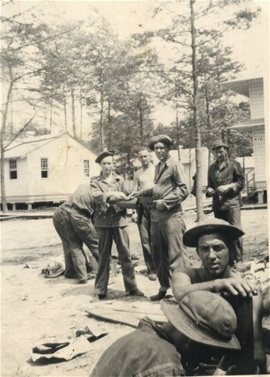 Company A Engineers train on the Browning Water Cooled Machine Gun
Company A Engineers train on the Browning Water Cooled Machine Gun
Training for the 85th Engineers began at Ft. Belvoir, Virginia. Ft. Belvoir was located 20 miles south of Washington, D.C., on 10 square miles of land adjacent to the Potomac River. North of Belvoir was
an old farm that was developed into the first ERTC (Engineer Recruit Training Center) in March of 1941. The ERTC included rows of two story frame barracks.
Engineers arriving at the Training Center were first given inoculations and GI haircuts. Then they were issued a gas mask, rifle, bayonet, an assortment of clothing, and a barracks assignment.
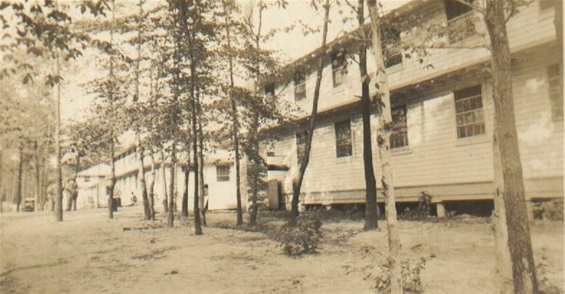 Company A Barracks at Ft. Belvoir
Company A Barracks at Ft. Belvoir
First Two Weeks of Training
During this time the 85th was attached to the U.S. First Army, and was divided up in groups common to a military regiment: Battalions; companies; platoons. Each company was set up in four barracks
and a mess hall.
For most of 1941 Engineer troops spent 12 weeks in basic military and engineer training. (Units located at Ft. Belvoir on Dec. 7, 1941 were: 43rd Engineer (General Services)
Regiment; 84th Engineer (Camouflage) Battalion; 85th Engineer (Heavy Ponton) Battalion; 95th Engineer (Separate) Battalion (Colored) ). This was later reduced to 8 weeks in December of 1941, and then changed back to 12 weeks in 1942.
For the first two weeks the trainee drilled and marched, pitched tents, watched training films, and learned to salute. They next graduated to the obstacle course for agility and endurance training. The obstacle course
at Belvoir was built in 1941 and was considered one of the best to test the endurance of troops. So much so it was copied throughout the U.S. Armed forces. It was built on some of the roughest terrain and formed a horseshoe shape that was 500 yards long. The
course required trainees to climb rope, jump hurdles, crawl through pipes, hop tires, and swing across flooded ravines.
First Four Weeks of Training
During the first four weeks the trainee spent some 15% of his time in marksmanship training. They received instruction in disassembly and assembly of their weapons, and spent many hours learning to fire
it. Due to a shortage in ammo, firing lessons were done using "dry fire" methods focusing mainly on the correct shooting positions of standing, kneeling, sitting, and prone. This was followed by actually firing the weapon. The trainee was graded as marksman,
sharpshooter, or expert depending upon their abilities. Belvoir had one 300 yard range that included 88 targets. Each soldier fired for record and the goal was to qualify 80% of the trainees. The 03 Sringfield was the weapon used at first. Due to shortages
there were not enough weapons to issue to each man. The M1 Carbine wasn't available until August of 42, and the M1 Garand rifle didn't arrive at the training centers until December of 1942.
Fifth Week of Training
During the fifth week, the final stage of training focused on Engineering subjects: demolitions; bridging; road construction; obstacles. This was seven weeks of tactical and technical training. The engineer
learned reconnaissance which focused on finding bridge sites, determining the width and flow of streams, and the contour of terrain for road building, tank obstacles, and mine fields. In tactics he learned to coordinate his efforts in different size groups
of squad, platoon, and company size. Weapons instruction shifted to groups, focusing on concentrating the fire power of small units. 20% of the trainees were to learn to fire the .30 cal machine gun (which was the principal issue crew served weapon),.50 cal
machine guns, and 37mm antitank guns. Technical training focused on building floating and fixed bridges and various types of roads and obstacles.
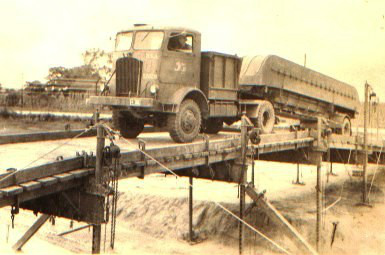 Each project was tested by having a Mack truck and trailor loaded with a heavy ponton drive over the bridge.
Each project was tested by having a Mack truck and trailor loaded with a heavy ponton drive over the bridge.
Maneuvers
For the 85th at Belvoir, floating bridge training took place on a dredged channel 2,000' long and 130' to 250' wide. The fixed bridge training took place over Accotink Creek. Both steel and wooden trestle
bridges were built here. In a typical week some 180 bridges were built in these areas. Each project was tested by having a truck and trailor loaded with a heavy ponton drive over the bridge.
Testing
the skills of the engineer was done in the field rather than on paper exams. Field testing in 1941 included Engineer participation in several U.S. Army maneuvers. The purpose of these maneuvers was to test the readiness of the U.S. military to take the field
at a moments notice. These exercises began in June of 1941, and would last until November of that same year. The Louisiana Maneuvers took place in Washington, Tennessee, Arkansas, Louisiana, and Texas. The '41 maneuvers finished up with the First Army doing
field exercises in the Carolinas during October and November. The tasks assigned to the 85th during these maneuvers was to bridge Oauchita River in Arkansas and the Red River at Campti, Louisiana. The Red River bridge was 1031' long and due to difficulties
in approach preparations it took 25hrs to build. This was the longest bridge built by Army Engineers since the Civil War. The 85th finished the '41 maneuvers at Ellerbe, North Carolina where they would bridge the Pee Dee River numerous times.
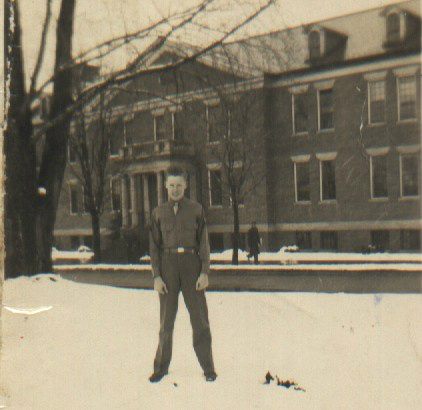 Milt O'Barr at Brick Barracks at Plattsburg
Milt O'Barr at Brick Barracks at Plattsburg
From Belvoir to Over Seas
On April 2, 1942 the 85th moved from Belvoir to Plattsburg Barracks, New York. Here they built bridges on Lake Champlain and the Salmon River. In June the 85th was ordered by rail to the North-South Carolina
maneuvers where again they practiced bridge building on the Pee Dee. Returning to Plattsburg on August 21, 1942 the 85th continued intensive training which included the involvement of cadets from West Point.
On October 14, 1942 the 85th traveled by rail to Camp Maxey, Texas. Here they engaged in the most intensive training yet. Lake Gibbons was the site for most of this work.
On
April 29, 1943 Company A of the 85th concluded training by shipping out for North Africa on the U.S.S. Monticello landing at Oran on May 11(took 13 days due to submarine evasion). A detachment of H&S Company arrived at Oran eleven days later aboard the
Santa Paula. (The remainder of the 85th would stay State side and continue training until the invasion of Southern France). These two companies met at Mostaganem, Africa for bridge training on the Cheliff River. From there they would head across North Africa
to the Port of Bizerte. Departing from Bizerte on LST's October 13, 1943, Company A and the detachment would head to Italy arriving on October 16. In Italy their training would be put to the test in a combat situation for the first time.
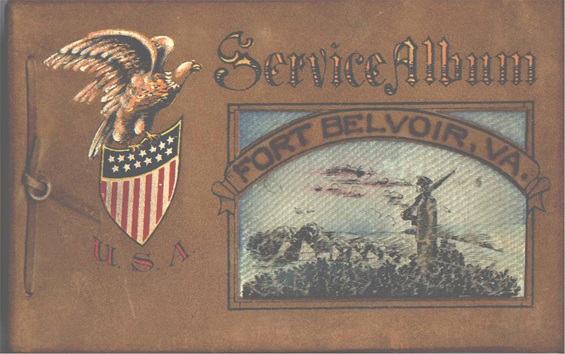 Belvoir Autograph Book signed by members of Company 'A' 85th
Belvoir Autograph Book signed by members of Company 'A' 85th
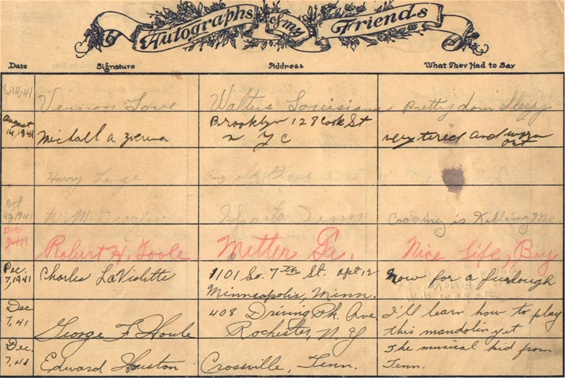 Autographs
Autographs
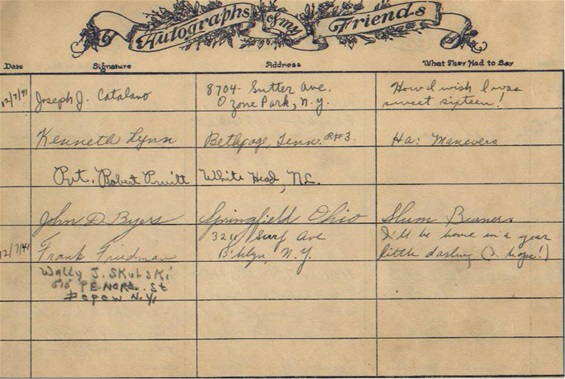 Autographs
Autographs
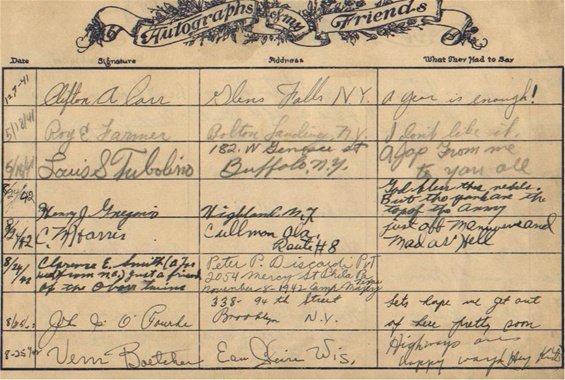 Autographs
Autographs
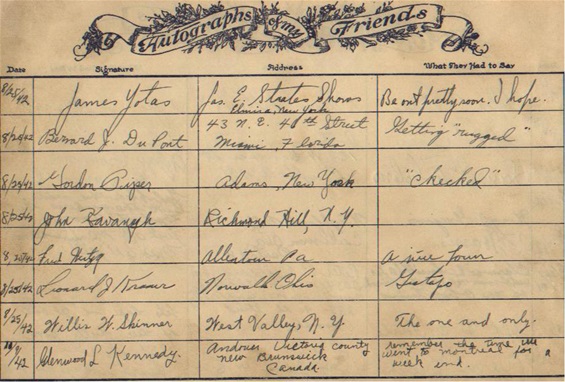 Autographs
Autographs
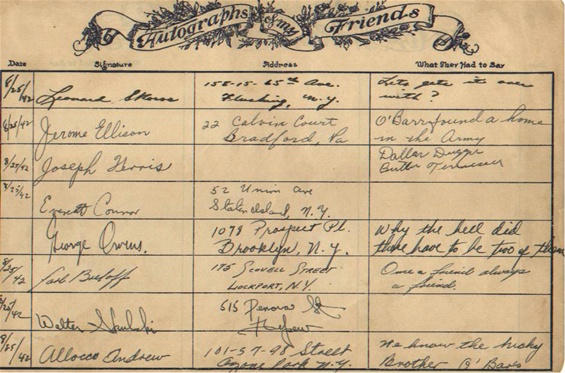 Autographs
Autographs
|
|
 |
|
|
|